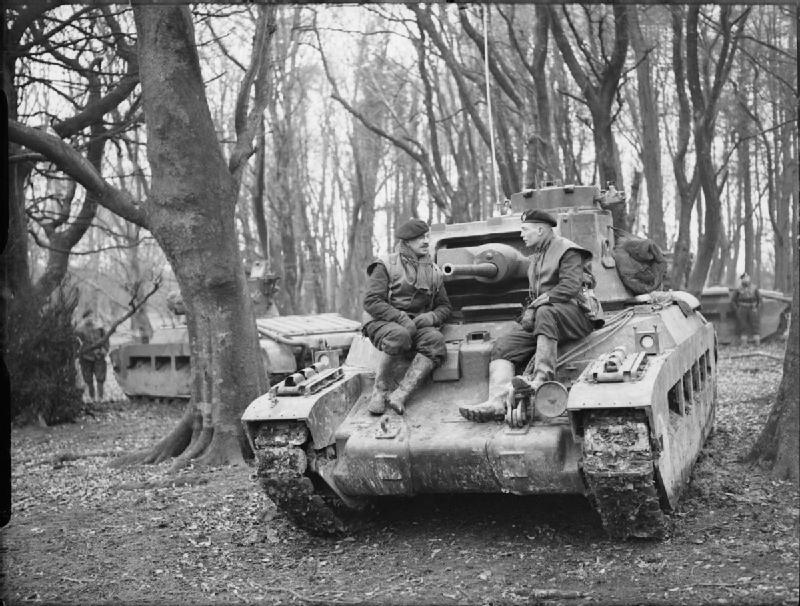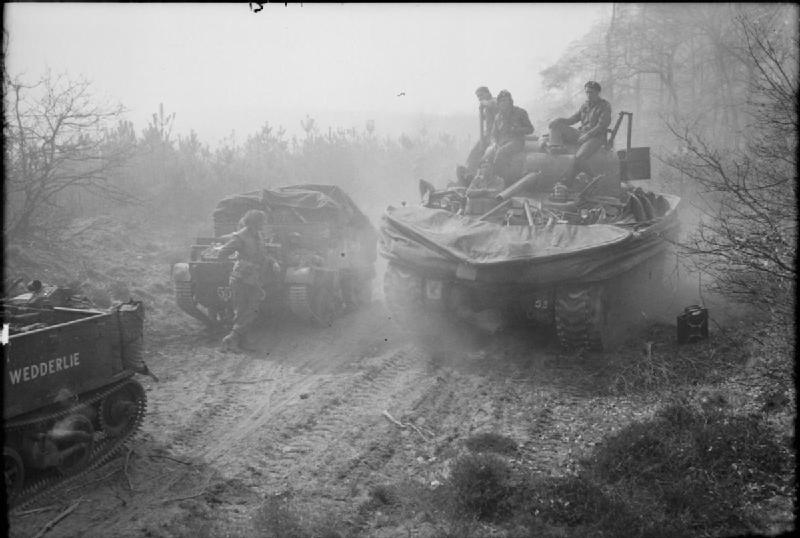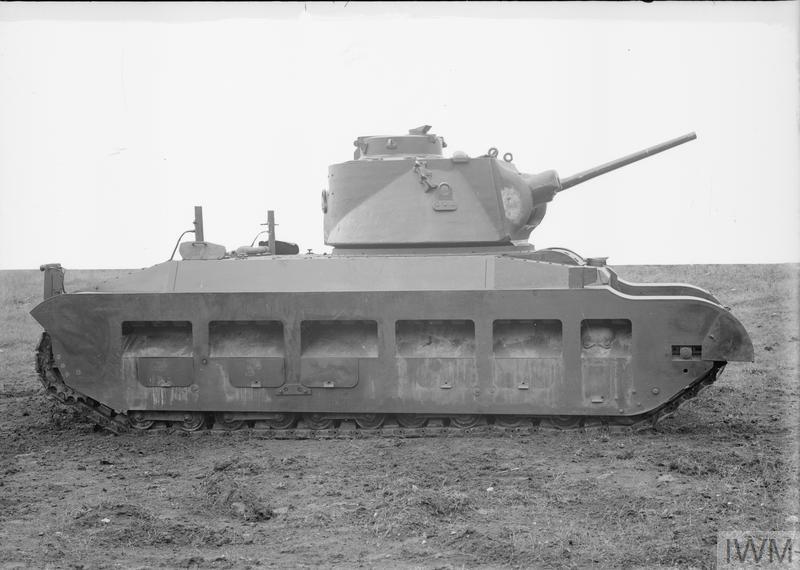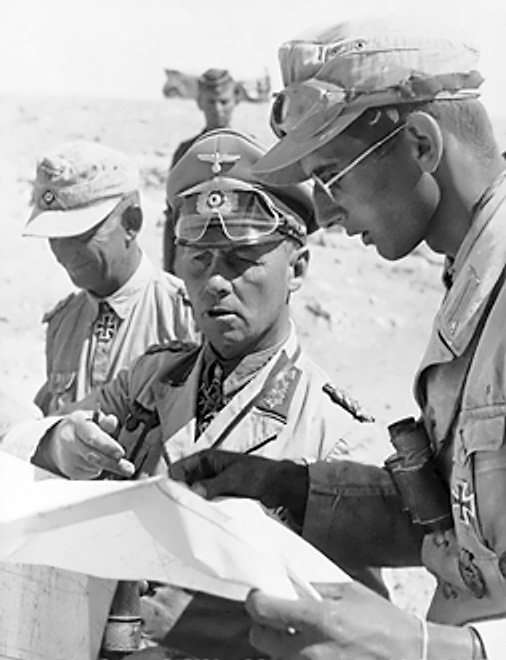|
44th Royal Tank Regiment
The 44th Royal Tank Regiment (44 RTR) was an armoured regiment of the British Army, which was part of the Royal Tank Regiment, itself part of the Royal Armoured Corps that saw active service in World War II. The 44th RTR was formed before World War II in 1938 from the 6th Battalion, Gloucestershire Regiment. When war was declared on 3 September 1939 44th RTR was in Bristol, attached to 21st Army Tank Brigade at the time, with the 42nd and 48th RTR. The battalion then went to the Middle East in April 1941 and by the time of Operation Crusader, November 1941, 1st Army Tank Brigade, equipped with Valentine tanks, along with 8th and 42nd RTR, supporting 2nd New Zealand Division, contributing to the Divisions stand against the German and Italian armoured attacks on 30 November 1941. It was still part of 1st Army Tank Brigade when the Germans and Italians attacked at Gazala in May 1942 and also in the Cauldron battles of that campaign. It then supported the Australians during the ... [...More Info...] [...Related Items...] OR: [Wikipedia] [Google] [Baidu] |
Royal Tank Regiment
The Royal Tank Regiment (RTR) is the oldest tank unit in the world, being formed by the British Army in 1916 during the First World War. Today, it is the armoured regiment of the British Army's 12th Armoured Infantry Brigade. Formerly known as the Tank Corps and the Royal Tank Corps, it is part of the Royal Armoured Corps. History First World War The formation of the Royal Tank Regiment followed the invention of the tank. Tanks were first used at the Battle of Flers–Courcelette in September 1916 during the Battle of the Somme in the First World War. They were at first considered artillery, and crews received artillery pay. At that time the six tank companies were grouped as the Heavy Section of the Machine Gun Corps (MGC). In November 1916 the eight companies then in existence were each expanded to form battalions (still identified by the letters A to H) and designated the Heavy Branch MGC; another seven battalions, I to O, were formed by January 1918, when all the battalions ... [...More Info...] [...Related Items...] OR: [Wikipedia] [Google] [Baidu] |
1st Army Tank Brigade (United Kingdom)
The 1st Army Tank Brigade was a formation of the British Army during the Second World War. A ''Tank'' Brigade was intended to support the Infantry and was mostly equipped with slow moving Infantry tanks, unlike an Armoured Brigade, which was equipped with faster cruiser tanks and later its own motorised infantry. Initially using infantry nomenclature for its smaller units, ''company '' and ''section'' and having 175 light and infantry tanks, it later adopted cavalry nomenclature of ''squadron'' and ''troop'' and later in the War grew to 240 tanks. History The 1st Army Tank Brigade took part in the Battle of France, serving as part of the British Expeditionary Force. It fought against the Germans in Belgium and Northern France, providing the armour for the counter-attack at the Battle of Arras and covered the Allied retreat to Dunkirk. It lost all of its equipment on the beaches following the evacuation. The reformed 1st Army Tank Brigade was transferred to North Africa, equip ... [...More Info...] [...Related Items...] OR: [Wikipedia] [Google] [Baidu] |
Operation Overlord
Operation Overlord was the codename for the Battle of Normandy, the Allies of World War II, Allied operation that launched the successful invasion of German-occupied Western Front (World War II), Western Europe during World War II. The operation was launched on 6 June 1944 (D-Day) with the Normandy landings. A 1,200-plane Airborne forces, airborne assault preceded an amphibious warfare, amphibious assault involving more than 5,000 vessels. Nearly 160,000 troops crossed the English Channel on 6 June, and more than two million Allied troops were in France by the end of August. The decision to undertake a cross-channel invasion in 1944 was taken at the Washington Conference (1943), Trident Conference in Washington, D.C., Washington in May 1943. General Dwight D. Eisenhower was appointed commander of Supreme Headquarters Allied Expeditionary Force, and General Bernard Montgomery was named commander of the 21st Army Group, which comprised all the land forces involved in the invasio ... [...More Info...] [...Related Items...] OR: [Wikipedia] [Google] [Baidu] |
Normandy Landings
The Normandy landings were the landing operations and associated airborne operations on Tuesday, 6 June 1944 of the Allied invasion of Normandy in Operation Overlord during World War II. Codenamed Operation Neptune and often referred to as D-Day, it was the largest seaborne invasion in history. The operation began the liberation of France (and later western Europe) and laid the foundations of the Allied victory on the Western Front. Planning for the operation began in 1943. In the months leading up to the invasion, the Allies conducted a substantial military deception, codenamed Operation Bodyguard, to mislead the Germans as to the date and location of the main Allied landings. The weather on D-Day was far from ideal, and the operation had to be delayed 24 hours; a further postponement would have meant a delay of at least two weeks, as the invasion planners had requirements for the phase of the moon, the tides, and the time of day that meant only a few days each month were ... [...More Info...] [...Related Items...] OR: [Wikipedia] [Google] [Baidu] |
Allied Invasion Of Sicily
The Allied invasion of Sicily, also known as Operation Husky, was a major campaign of World War II in which the Allied forces invaded the island of Sicily in July 1943 and took it from the Axis powers ( Fascist Italy and Nazi Germany). It began with a large amphibious and airborne operation, followed by a six-week land campaign, and initiated the Italian campaign. To divert some of the Axis forces to other areas, the Allies engaged in several deception operations, the most famous and successful of which was Operation Mincemeat. Husky began on the night of 9–10 July 1943 and ended on 17 August. Strategically, Husky achieved the goals set out for it by Allied planners; the Allies drove Axis air, land and naval forces from the island and the Mediterranean sea lanes were opened for Allied merchant ships for the first time since 1941. These events led to the Italian leader, Benito Mussolini, being toppled from power in Italy on 25 July, and to the Allied invasion of Italy on 3 ... [...More Info...] [...Related Items...] OR: [Wikipedia] [Google] [Baidu] |
4th Infantry Brigade And Headquarters North East
4th Infantry Brigade and Headquarters North East, previously known as 4th Mechanized Brigade and before that 4th Armoured Brigade is a brigade formation of the British Army, currently based in Catterick, North Yorkshire as part of 1st (United Kingdom) Division. The brigade, now known as the 'Black Rats', was formed in 1939 and fought in the Second World War in the Western Desert Campaign in North Africa. The Black Rats were subsequently involved in the invasion of Sicily and fighting in Italy before taking part in the Battle of Normandy and the advance through Belgium, Holland and into Germany. More recently, the Brigade took part in the First Gulf War and completed a number of tours to the Balkans during the 1990s. The Black Rats have also since deployed twice to Iraq and twice to Afghanistan as the lead formation. History Second World War In September 1939, at the start of the Second World War this brigade changed its title from Heavy Armoured Brigade (Egypt) t ... [...More Info...] [...Related Items...] OR: [Wikipedia] [Google] [Baidu] |
Second Battle Of El Alamein
The Second Battle of El Alamein (23 October – 11 November 1942) was a battle of the Second World War that took place near the Egyptian Railway station, railway halt of El Alamein. The First Battle of El Alamein and the Battle of Alam el Halfa had prevented the Axis powers, Axis from advancing further into Egypt. In August 1942, General (United Kingdom), General Claude Auchinleck had been relieved as Commander-in-Chief Middle East Command and his successor, Lieutenant-General William Gott was killed on his way to replace him as commander of the Eighth Army (United Kingdom), Eighth Army. Lieutenant-general (United Kingdom), Lieutenant-General Bernard Montgomery was appointed and led the Eighth Army offensive. The British victory was the beginning of the end of the Western Desert Campaign, eliminating the Axis threat to Egypt, the Suez Canal and the Middle Eastern and Persian oil fields. The battle revived the morale of the Allies, being the first big success against the Axis sin ... [...More Info...] [...Related Items...] OR: [Wikipedia] [Google] [Baidu] |
Matilda II
The Infantry Tank Mark II, best known as the Matilda, was a British infantry tank of the Second World War.Jentz, p. 11. The design began as the A12 specification in 1936, as a gun-armed counterpart to the first British infantry tank, the machine gun armed, two-man A11 Infantry Tank Mark I. The Mark I was also known as Matilda, and the larger A12 was initially known as the Matilda II or Matilda senior. The Mark I was abandoned in 1940, and from then on the A12 was almost always known simply as "the Matilda". With its heavy armour, the Matilda II was an excellent infantry support tank but with somewhat limited speed and armament. It was the only British tank to serve from the start of the war to its end, although it is particularly associated with the North Africa Campaign. Only two were available for service by the outbreak of the World War II in 1939. It was replaced in front-line service by the lighter and less costly Infantry Tank Mk III Valentine beginning in late 1941. D ... [...More Info...] [...Related Items...] OR: [Wikipedia] [Google] [Baidu] |
First Battle Of El Alamein
The First Battle of El Alamein (1–27 July 1942) was a battle of the Western Desert campaign of the Second World War, fought in Egypt between Axis (German and Italian) forces of the Panzer Army Africa—which included the under Field Marshal Erwin Rommel—and Allied (British Imperial and Commonwealth) forces of the Eighth Army under General Claude Auchinleck. The British prevented a second advance by the Axis forces into Egypt. Axis positions near El Alamein, only from Alexandria, were dangerously close to the ports and cities of Egypt, the base facilities of the Commonwealth forces and the Suez Canal. However, the Axis forces were too far from their base at Tripoli in Libya to remain at El Alamein indefinitely, which led both sides to accumulate supplies for more offensives, against the constraints of time and distance. The battle and the Second Battle of El Alamein three months later remain important to some of the countries that took part. In New Zealand, this is ... [...More Info...] [...Related Items...] OR: [Wikipedia] [Google] [Baidu] |
9th Division (Australia)
The 9th Division was a division of the Australian Army that served during World War II. It was the fourth division raised for the Second Australian Imperial Force (2nd AIF). The distinctions of the division include it being: * in front line combat longer, cumulatively, than any other Australian division;Johnston (2002), p. ix. * one of the Australian military's most decorated formations; * the only 2nd AIF division formed in the United Kingdom, from infantry brigades and support units formed in Australia; * praised by both Allied and Axis generals, including Bernard Montgomery and Erwin Rommel, as well as non-Australian military historians, and; * like the 6th and 7th Divisions, being one of only a few Allied army units to serve in both the Mediterranean and Pacific theatres. During 1940, the component units of the 9th Division were sent to the UK to defend it against a possible German invasion. After serving during 1941–1942 in the North African campaign, at the Sieg ... [...More Info...] [...Related Items...] OR: [Wikipedia] [Google] [Baidu] |
Battle Of Gazala
The Battle of Gazala (near the village of ) was fought during the Western Desert Campaign of the Second World War, west of the port of Tobruk in Libya, from 26 May to 21 June 1942. Axis troops of the ( Erwin Rommel) consisting of German and Italian units fought the British Eighth Army (General Sir Claude Auchinleck, also Commander-in-Chief Middle East) composed mainly of British Commonwealth, Indian and Free French troops. The Axis troops made a decoy attack in the north as the main attack moved round the southern flank of the Gazala position. Unexpected resistance at the south end of the line around the Bir Hakeim box by the Free French garrison, left with a long and vulnerable supply route around the Gazala Line. Rommel retired to a defensive position backing onto Allied minefields (the Cauldron), forming a base in the midst of the British defences. Italian engineers lifted mines from the west side of the minefields to create a supply route through to the Axis side. Ope ... [...More Info...] [...Related Items...] OR: [Wikipedia] [Google] [Baidu] |







